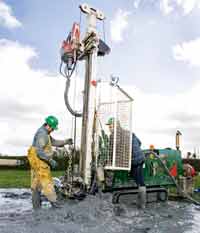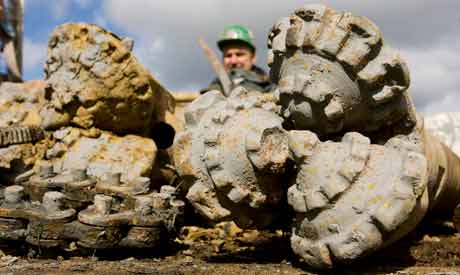Want cheaper water? What about a borehole?

Everyone knows of a farm with a borehole. Some are recent additions, while others have been around as long as anyone working on the farm can remember. But all are useful, if not essential to the farm.
| Take a look at our short VIDEO on borehole-making |
|---|
With water costs escalating and abstraction regulations easing thanks to the Water Act 2003, users can now extract up to 20cu m of water a day, more than enough for an average family and even enough to cope with a dairy herd of 150 cows or so, depending on the system.
Jackson Drilling has been operating as a specialist drilling company since 1973. Although it deals with site surveys and fancy things like geothermal heating, a lotof its business comes from farmers looking to save money on water bills, says owner Ros Clapp.
Husband Rob, who runs a 500-cow dairy in partnership with his father and uncle, has opted to go down the borehole route.
So, what’s the first step? The first thing is to have a prognosis carried out, based on a hydrological survey. “We use an external consultant to do this and usually it takes about a week,” she says.
“We use a combination of the prognosis results and what a diviner finds to establish where the best place to drill is. Although there’s no science behind divining, it adds to the information. At West Town House Farm, the prognosis suggestedwater at 40-45m whereas the diviner reckoned 60m, which is in the region we actually found water.” In the UK, the geology is so different from place to place that a combination of the two is important.
Until a borehole has been drilled, it’s difficult to predict exactly how much water you will be able to extract. “The prognosis will give some indication, and for this farm there’s an 80% chance of obtaining 20cu m a day and a 40% of getting 40cu m. There’s a 90% chance that the quality of what is obtainable is drinkable by cattle.”
Broadly, it all depends on the aquifer system and boreholes can be fed by seeping water or from a water cavity.
Geology also determines how deep you have to drill. “An average depth is between60 and 100m, but we have drilling rigs capable to drill beyond this depth if necessary.”
You can legally extract up to 20cu m (4400gal) a day without having to gain a licence from the Environment Agency, but you should register your borehole, says Mrs Clapp.
Because the limit for extraction without a licence is 20cu m a day, it’s important to know how the supply will fit in with the system and what it will be used for. “Here, it will be predominantly used for washing and also plate cooling, as despite the time of year, extracted water will always be at a constant temperature of about 10C.
“If the prognosis had said it was unlikely we’d get more than 10cu m, we’d have to question the viability of running the pipework.

Depending on the geology, different drill bits and procedures will be used
“You have to factor in how much it will cost to pump the water to where the primary use is going to be. It’s a good idea to choose where the ideal place is before you call a diviner in. Also, the borehole should be located upslope and at least 25m away from any slurry store to prevent contamination,” she says.
The borehole itself will be flush to the ground, with underground pipework and an external electric supply for monitoring in housing nearby.
Depending on whether you plan to extract more than 20cu m, the prognosis can be done in a week, the site survey shortly after and there’s a lead-in time of betweenoneand two weeks. “Drilling itself depends on what soil type you’re on and the geology of the area. For example, we’re on clay here, so we haven’t had to put casing all the way down the hole, only for the first 9m to prevent the top of the hole collapsing. If we were drilling into sand or unconsolidated material, we’d have to case the whole length we’d drilled or drill with a mud polymer to support the sides.”
When the location is chosen, the drilling rig, in this case a Comacchio Geo205, will drill to the prescribed depth, using a mixture of air and water to bring the material to the surface.
“Once the depth is reached, and when the rig has found water, a basic way of seeing what the flow rate is without having to install a pump is to use air to get the water from the hole and time the recharge,” says Mrs Clapp. Alternatively, for a more accurate measure, a pump test can be carried out and this usually runs from eight hours up to a week to establish the recharge.
When this is completed, the 200mm (8in) diameter borehole is lined with a well screen and casing, usually made of PVC. The screens have slots to allow the full water potential of the aquifer to seep through.
Slots are designed to bring water in and the screen will be surrounded with a filter pack, in this case 10mm gravel, she adds. “In sandy soil, we’ve had to use a finer filter pack, and you can cover the pipe with a sock for extra filtration. It’s important to spend money on the right filter pack for the conditions.”
The plain section of the pipe is sealed with bentonite pellets which swells, sets and closes the opening. This prevents any surface water migrating into the water table.
“As it’s a long-term investment, it’s important to buy good quality pipework. In some cases steel is used to line the borehole but PVC is more commonly used, it is durable and should last more than 20 years and some say a lifetime.”
How much does it cost? A rough estimate would be between £4000 and £6000, which includes the prognosis, site report, pipework and drilling time. But, depending on conditions, holes can be dug and pipework installed for as little as £2000.
Once the borehole has been drilled, the only cost is the electricity required to run the pump, a considerable saving on the £1.69/cu m charged by some water companies.

